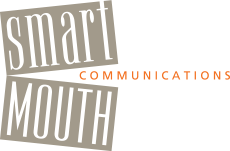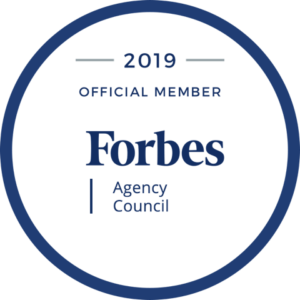SmartMouth Talks!
It’s Super Bowl Time!
I am not a football fan, but I love the weeks leading up to the Super Bowl. These weeks are rich with athletes talking on-camera about winning, losing, how they feel, what they were thinking, predictions for the future, etc. Their performances on-camera vary wildly … for me, it’s more fun to watch the interviews than the games!
Here’s what so often perplexes me, though. (Listen up, you office types, this applies to you too!) All too often the athletes seem unprepared for the questions. Really? You weren’t expecting that? I’m scratching my head … there are only two potential outcomes to an athletic competition, winning and not winning. And there’s a set of pretty predictable questions. Surely, an athlete can mentally prepare for at least minute to get his head around how he’d like to frame up each of those situations.
This is really true for most of us who are called upon to speak … maybe not into a TV camera, but certainly in meetings and in other typical venues. We act like we weren’t expecting to have to speak. Really? Why aren’t we always at-the-ready? Are we working on that project, are we responsible for that client, are we a member of the staff that is having the staff meeting? Well then, we need to buck up … and spend a minute or two getting our heads around what we’d like everyone to know and remember about our work.
On the field or in the office, I say plan for and play good offense … playing defense is a lot harder!
Go up to 30,000 ft: Messages vs. Information
Making a good impression. Being memorable. Commanding respect and attention. Having an elevator pitch. All worthy, all very fleeting, opportunities. But how do you get there?
Get out of the weeds and go up to 30,000 ft., that’s how!
Easier said than done, so let’s start with baby steps. First, challenge yourself to recognize the difference between a message and information. A message is a visionary, thematic, or bigger picture statement … it’s the super high-altitude stuff. A message conveys value or benefit or significance. Information is data, lists, or examples. Information conveys features … it’s the weeds. Information obviously is useful and often necessary, but it can get lost – and your point can get lost – if it’s not packaged and wrapped inside of a message. Think WHY vs. WHAT; and think about why first, and then what.
Take, for example, the all-important personal introduction or elevator pitch for yourself, your organization, or your project. Needs to be brief. Needs to make a good impression. Needs to be memorable. Needs to command respect and attention. Rather than introducing yourself with name, rank and serial number (all hardcore info), go up to 30,000 ft and introduce yourself with a statement of why, a statement of vision, or a statement of value. Time permitting, you can then layer on some information.
Going up to 30,000 ft. and “going big” on messaging is hard, it takes some thought and some work. It may even take some poking and prodding from a friend or a coach. But if you can get there, the impression you leave will be enormously improved.
Your professional role may or may not demand that you be at 30,000 ft all the time, but certainly when time is limited and you need to be brief, you have no choice but to get out of the weeds and go straight up to 30,000 ft.
The view of you will be better when you’re up there!
Last Call for Talkers …
SmartTalkers, that is. SmartTalk (www.smartmouthgroup.com/events) begins on Wednesday, and I can’t wait!
Two groups of intrepid participants have signed up to try out this new pilot program I’m launching in Salt Lake City this year. SmartTalkers will do two things: they will learn how to bust through some of the mediocrity we all tolerate in presentations these days, and they will practice, practice, practice. It’ll be a workout for the brain and the mouth! And it’ll be fun, of course.
The SmartTalk groups comprise interesting and diverse professionals, yet all are successful and ambitious. I’m honored to be leading these groups and to have this opportunity to enhance some already very talented skill sets.
So watch out, there could be a professional in your office who starts to knock your socks off in the coming months! Let’s hope so …
Are You Really as Interesting as You Could Be?
Last week, I pooh-poohed the mirror, I know. And this week, I’m asking you to take a good look at yourself … Are you really as interesting as you could be?
A couple of litmus tests for when you’re preparing to address a group:
- 1. Do you have something super useful, meaningful, or beneficial to leave them with? Regardless of your topic, you need to think about and identify what that little nugget of value might be. A play on words to help you remember: Give your audience a present when you present.
- 2. Are you talking about yourself or them? And if it’s about you, are you relating it to them? They say that a person’s attention span is significantly heightened when they hear the sound of their own name. Take a lesson from that; people like to hear about themselves.
- 3. Have you found a way to be entertaining or memorable? Do you have some presentation bling? Have you thought about what that might be? Anything from stories to poetry to pictures works. Think about what you might have in your arsenal.
If you can pass these litmus tests, you’re probably pretty interesting, congrats! If not, give some thought to the above … and we’ll talk.
Practice in Front of a Mirror?
This is one of the most common pieces of advice I overhear when it comes to public speaking. In fact, I heard it just last week. Again. You’ve heard it too. But I’m calling phooey on the mirror.
Think about it. Practice in front of a mirror … Really? Why? Because it simulates reality? Because you are your most objective audience? Because looking at yourself talk will make you less nervous when it’s show time?
Folks, I don’t buy it. I love the idea of practice … if nothing else, practice at least gets you accustomed to managing your own nerves. And that’s actually something. Your nerves are your adrenaline, your body’s energy ramping itself up to perform and succeed. You need your nerves, and you need the experience of having and managing them rather than avoiding the speaking opportunity. But you also need some 360º feedback.
Practice in front of people, that’s what I suggest … colleagues, teammates, friends, and even family members. There’s nothing like a real audience, even a small one, who will give you feedback. I’ve seen real audiences, even small ones, who will give me feedback … but I’ll be honest, I’ve never seen one of those in the mirror!
Resolutions
Whoa, December madness! But not in the way you’re thinking. Yes, it’s a busy month for shopping, celebrations, family and friends. But it also brings the busy anticipation of starting anew … and with that, resolutions!
The December madness I’m experiencing is the flurry of interest and motivation around being better. Better than they were last year, better than the competition, better than expected. Companies, organizations, and individual professionals always seem to inquire in December about the availability of workshops and coaching in order to be better speakers and presenters. The New Year is indeed a time to freshen, improve, and renew oneself. It’s also a time to buck the status quo, challenge oneself, and shoot for excellence! People are thinking about their resolutions for 2011 right now, and they aren’t just signing up at gyms for their bodies, they’re looking for places to work out their brains and their mouths too.
The December launch of SmartTalk has been timely indeed … http://smartmouthgroup.com/events.htm. Here’s to fresh starts … Let’s talk in 2011!
3 Tips for Leaders
Ahhhh, “leadership communications” with a group tomorrow … I always love that!
Soooo, what will I inspire them to think about? Their role. People in leadership positions have a higher responsibility when it comes to how they communicate and present themselves than ordinary people do. Leader is a role. And, like any good actor or role-player, leaders have to stay in that role at all times in order to hold onto the credibility and respect they need, and also to be able to stand up to whatever scrutiny they may endure from peers or subordinates.
A couple of tips I will cover …
1) being transparent, especially in their opening;
2) being positive and affirmative all the time, even when the message or purpose is difficult or bad; and
3) being brief.
Good leaders are direct, upbeat, and to the point. And they understand that, as hard as it is sometimes, they cannot let it all hang out … their role requires them to hold it all together. People are counting on them, and their role depends on it.
Got This Text Message …
A is for Audience
In my work, I often capitalize the A in Audience to make a point.
That’s my blog post. It speaks for itself.
Be Disruptive!
I think it’s high time for speakers and presenters to be disruptive. And here are a few ways to begin …
Do you really need to fill the time allotted to you?
Really? Or can you be brief? Why fill it just because you can? So what if you were told you have 45 minutes? Do you like to sit and listen to someone talk for 45 minutes straight?
Do you really need your laptop and your PowerPoint?
Really? Or can you do the prep work ahead of time that enables you to engage, connect, and make a point without employing a “deck”? So what if that’s how you and your colleagues have always done it? Do you like waiting for someone to power up and plod through a series of slides? You’re not that special, no one likes waiting for you either.
Do you really need text slides for visual reinforcement?
Really? Or can you use images that illustrate your points? Who’s the text for anyway? You or them? Do you like to read paragraphs on a screen while someone is talking? Are you impressed with presenters whose slides are dense with text? Do you remember what the slides said and what the speaker said? Doubtful.
Do you really need to open with niceties and housekeeping?
Really? Or can you open with your point, your desired outcome, your call to action, and save the display of manners and protocol for the end? Wouldn’t you rather capture and focus Audience attention right away? You know how your own attention drifts when other speakers start with the usual, expected, mundane stuff … And guess what? People drift when you speak too.
Do you really need to show how smart and experienced you are?
Really? Or do you need to show how smart you are about your Audience? Disruption rule #1: Get over yourself. Literally. Think about your Audience. Really, I mean it, think about them. Deliver something in length, style, and content that will connect with and be beneficial to your Audience!
Be disruptive. Question authority. Question norms. Make it about your Audience.



